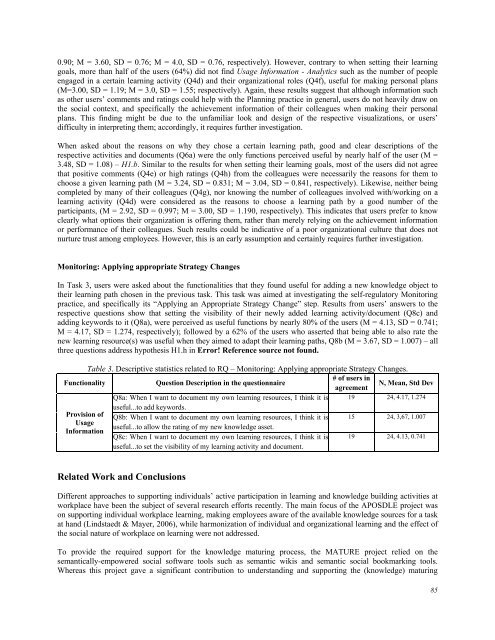October 2012 Volume 15 Number 4 - Educational Technology ...
October 2012 Volume 15 Number 4 - Educational Technology ...
October 2012 Volume 15 Number 4 - Educational Technology ...
You also want an ePaper? Increase the reach of your titles
YUMPU automatically turns print PDFs into web optimized ePapers that Google loves.
0.90; M = 3.60, SD = 0.76; M = 4.0, SD = 0.76, respectively). However, contrary to when setting their learning<br />
goals, more than half of the users (64%) did not find Usage Information - Analytics such as the number of people<br />
engaged in a certain learning activity (Q4d) and their organizational roles (Q4f), useful for making personal plans<br />
(M=3.00, SD = 1.19; M = 3.0, SD = 1.55; respectively). Again, these results suggest that although information such<br />
as other users’ comments and ratings could help with the Planning practice in general, users do not heavily draw on<br />
the social context, and specifically the achievement information of their colleagues when making their personal<br />
plans. This finding might be due to the unfamiliar look and design of the respective visualizations, or users’<br />
difficulty in interpreting them; accordingly, it requires further investigation.<br />
When asked about the reasons on why they chose a certain learning path, good and clear descriptions of the<br />
respective activities and documents (Q6a) were the only functions perceived useful by nearly half of the user (M =<br />
3.48, SD = 1.08) – H1.b. Similar to the results for when setting their learning goals, most of the users did not agree<br />
that positive comments (Q4e) or high ratings (Q4h) from the colleagues were necessarily the reasons for them to<br />
choose a given learning path (M = 3.24, SD = 0.831; M = 3.04, SD = 0.841, respectively). Likewise, neither being<br />
completed by many of their colleagues (Q4g), nor knowing the number of colleagues involved with/working on a<br />
learning activity (Q4d) were considered as the reasons to choose a learning path by a good number of the<br />
participants, (M = 2.92, SD = 0.997; M = 3.00, SD = 1.190, respectively). This indicates that users prefer to know<br />
clearly what options their organization is offering them, rather than merely relying on the achievement information<br />
or performance of their colleagues. Such results could be indicative of a poor organizational culture that does not<br />
nurture trust among employees. However, this is an early assumption and certainly requires further investigation.<br />
Monitoring: Applying appropriate Strategy Changes<br />
In Task 3, users were asked about the functionalities that they found useful for adding a new knowledge object to<br />
their learning path chosen in the previous task. This task was aimed at investigating the self-regulatory Monitoring<br />
practice, and specifically its “Applying an Appropriate Strategy Change” step. Results from users’ answers to the<br />
respective questions show that setting the visibility of their newly added learning activity/document (Q8c) and<br />
adding keywords to it (Q8a), were perceived as useful functions by nearly 80% of the users (M = 4.13, SD = 0.741;<br />
M = 4.17, SD = 1.274, respectively); followed by a 62% of the users who asserted that being able to also rate the<br />
new learning resource(s) was useful when they aimed to adapt their learning paths, Q8b (M = 3.67, SD = 1.007) – all<br />
three questions address hypothesis H1.h in Error! Reference source not found.<br />
Table 3. Descriptive statistics related to RQ – Monitoring: Applying appropriate Strategy Changes.<br />
Functionality Question Description in the questionnaire<br />
# of users in<br />
agreement<br />
N, Mean, Std Dev<br />
Q8a: When I want to document my own learning resources, I think it is 19 24, 4.17, 1.274<br />
useful...to add keywords.<br />
Provision of<br />
Usage<br />
Information<br />
Q8b: When I want to document my own learning resources, I think it is<br />
useful...to allow the rating of my new knowledge asset.<br />
Q8c: When I want to document my own learning resources, I think it is<br />
useful...to set the visibility of my learning activity and document.<br />
<strong>15</strong><br />
19<br />
24, 3,67, 1.007<br />
24, 4.13, 0.741<br />
Related Work and Conclusions<br />
Different approaches to supporting individuals’ active participation in learning and knowledge building activities at<br />
workplace have been the subject of several research efforts recently. The main focus of the APOSDLE project was<br />
on supporting individual workplace learning, making employees aware of the available knowledge sources for a task<br />
at hand (Lindstaedt & Mayer, 2006), while harmonization of individual and organizational learning and the effect of<br />
the social nature of workplace on learning were not addressed.<br />
To provide the required support for the knowledge maturing process, the MATURE project relied on the<br />
semantically-empowered social software tools such as semantic wikis and semantic social bookmarking tools.<br />
Whereas this project gave a significant contribution to understanding and supporting the (knowledge) maturing<br />
85

















